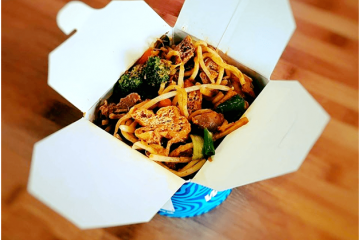
Delicious Original Chicken and Rice Recipe That Will Satisfy Your Cravings
Unlocking the Secrets: The Perfect Balance of Chicken and Rice
Choosing the Right Chicken: Freshness Matters
When it comes to creating a chicken and rice dish that resonates with flavor and tenderness, the selection of chicken plays a pivotal role. Opting for fresh chicken, preferably sourced from local farms or reputable butcher shops, can make a significant difference in the final product. Fresh chicken is typically more flavorful and moist than frozen varieties, which may have been previously frozen and thawed, potentially affecting texture and taste. It’s also essential to pay attention to the type of chicken you choose; for instance, free-range or organic options are often deemed superior due to their enriched diet and humane living conditions, directly impacting the depth of flavor. Additionally, specific cuts, such as thighs or a whole chicken cut into pieces, will yield different results. Bone-in, skin-on pieces tend to provide rich flavor with added moisture during cooking, while boneless skinless chicken breasts are a leaner option but require careful handling to avoid dryness. A well-informed choice at this initial stage sets the foundation for a delicious dish.
Rice Varieties: Which One Will Elevate Your Dish?
The choice of rice is not merely a secondary element in chicken and rice; it can elevate the entire dish from mundane to extraordinary. The grain’s texture, flavor, and cooking properties significantly influence the overall experience. Long-grain rice like Basmati or Jasmine rice offers a fluffy texture and aromatic qualities that complement the savory elements of chicken beautifully. Short-grain rice, such as Arborio or sushi rice, lends an entirely different texture; its stickiness can create a comforting cohesion in the dish, often found in Asian-inspired variants. Brown rice, known for its nutty flavor and hearty texture, provides a more robust profile and is an excellent option for health-conscious eaters, as it retains more nutrients. Moreover, experimenting with flavored rice, such as saffron-infused or coconut rice, can introduce a new dimension to your chicken and rice recipe. Consider the cooking times and liquid ratios; while white rice typically requires a 1:2 ratio, brown rice often demands a longer cooking time and more liquid. Understanding these nuances allows you to choose the appropriate rice that aligns perfectly with your culinary vision.
The Art of Seasoning: A Flavorful Symphony
Seasoning is the soul of any chicken and rice recipe. A well-executed blend of herbs, spices, and aromatics can transform a simple dish into a culinary masterpiece. Begin with a base of aromatics—onions, garlic, and ginger are staples across various cuisines and lay an excellent foundation for flavor. From there, explore traditional seasonings that enhance the chicken’s natural taste. For instance, the use of smoked paprika can introduce a warm, earthy note, while herbs like thyme and rosemary infuse an aromatic quality that elevates the dish’s profile. In addition to dried spices, consider using fresh herbs as a finishing touch to invigorate the dish right before serving. Embracing the unique flavor combinations found in global cuisines can also inspire you. Think of cilantro and lime for a Latin flair or saffron and lemon for a Mediterranean twist. When seasoning chicken, remember that applying salt too early in the cooking process can draw out moisture, so timing is crucial. It is advisable to season generously but taste as you go, creating a perfect harmony of flavors that delights the palate.
Mastering Techniques: Cooking Methods That Make a Difference
Stovetop Versus Oven: Finding Your Cooking Style
The debate between stovetop cooking and oven roasting often comes down to personal preference and the desired outcome. Cooking original chicken and rice on the stovetop offers precise control over the cooking process. This method allows for constant monitoring, adjustment of liquid levels, and immediate responses to evolving flavor profiles throughout the cooking. Making a classic chicken and rice dish on the stovetop often involves searing the chicken for a golden crust before adding rice and broth for a one-pot meal. The stovetop method is not only simple but also time-efficient, making it an appealing option for weeknight dinners. On the other hand, oven roasting delivers a unique quality by allowing the heat to surround the chicken evenly, resulting in a tender, succulent texture with slightly crispy skin. When baking, consider enveloping the dish in foil or a Dutch oven to trap moisture and flavors. The oven can also be a more forgiving method, allowing for unattended cooking, which is ideal for busy cooks. Regardless of the method chosen, be sure to understand the intricacies of each technique and adapt accordingly to create a memorable chicken and rice experience.
One-Pot Wonders: Simplicity Meets Flavor
In an age where convenience is key, the concept of one-pot meals has surged in popularity, and for good reason. One-pot chicken and rice dishes encapsulate ease and depth of flavor without the hassle of multiple pans. Utilizing techniques such as layering and careful timing, you can achieve a fully realized meal in a single vessel. Beginning with a sear of the chicken creates a base layer of flavor that infuses throughout the cooking process. Follow up by sautéing your aromatics and spices right in the same pot, allowing the residual fats from the chicken to meld with the flavors, creating a rich base. Add your rice and appropriate liquids, maintaining a balance that allows the rice to soak up the chicken’s essence while preventing dryness. The key here is to monitor cooking times judiciously, ensuring the rice absorbs all the delicious juices without becoming mushy. After removing the pot from heat, a brief resting period enhances the dish as flavors continue to meld and develop. Embracing one-pot dishes not only simplifies cleanup but also encourages creativity and resourcefulness in the kitchen.
Slow Cooking Magic: Transforming Ingredients Into Culinary Gems
Slow cooking is a transformative technique that infuses heartiness and tenderness into favorite comfort foods. When applied to chicken and rice, this method unlocks a depth of flavor that rivals traditional cooking techniques. The gradual heat of a slow cooker not only tenderizes tougher cuts of meat but also allows the spices and aromatics to penetrate every layer of the dish, creating a harmonious interplay of flavors. Start by browning the chicken in a skillet to maintain that richness, then transfer it to the slow cooker along with your chosen rice, broth, and seasonings. The slow cooker does all the work, permitting you to go about your day while the flavors meld. A crucial consideration regarding slow-cooked dishes is the liquid-to-rice ratio, as rice will continue to absorb liquid throughout the cooking process. Adjusting accordingly can prevent the grains from becoming overly soggy and ensures a balanced texture. When you finally unveil the treasure from the slow cooker, you are greeted by a warm, aromatic offering that feels as if it has been simmered all day in love.
Delicious Variations: Exploring Unique Twists on Chicken and Rice
Global Inspiration: Recipes From Around the World
Chicken and rice are enjoyed in countless forms across the globe, each reflecting local culture, ingredients, and culinary traditions. From the fragrant biryani of South Asia, where chicken is marinated in rich spices and layered with rice and saffron, to the savory Spanish paella, which incorporates an array of seafood, meats, and vibrant saffron-infused rice, the possibilities are endless. The Mediterranean offers its own variations, such as Greek chicken and rice pilaf, often served with tzatziki sauce, providing a refreshing contrast to the savory dish. Exploring Caribbean cuisine opens avenues for jerk chicken, infused with spicy and aromatic flavors, served alongside coconut rice. As you travel through these cultures via their culinary traditions, think about adapting techniques or flavors that resonate with you, allowing for creativity in your kitchen. These global variations not only educate but invite you to appreciate the versatility and adaptability of this beloved dish.
Vegetarian Alternatives: Satisfying Cravings Without the Meat
In today’s culinary landscape, the demand for vegetarian and plant-based alternatives has surged, and chicken and rice can easily be transformed to satisfy those cravings without using meat. Replacing chicken with hearty vegetables such as eggplant, mushrooms, or jackfruit introduces substantial texture and flavor. For instance, marinating mushrooms in soy sauce and spices offers umami depth that mimics chicken’s savory profile. Grains like quinoa, farro, or even cauliflower rice can substitute in place of standard rice, enriching the dish nutritionally and texturally. Incorporating legumes, such as chickpeas or lentils, can provide additional protein, creating a hearty meal that stands alone or pairs beautifully with vibrant sauces like tahini or salsa verde. The key when experimenting with vegetarian chicken and rice is to retain that satisfying, comforting quality inherent in the original dish while being unafraid to innovate and explore new combinations of vegetables, grains, and seasonings.
Fusion Flair: Mixing Cultures for an Exciting Dish
The art of fusion cooking encourages blending ingredients and techniques from diverse culinary traditions, producing exciting and innovative dishes that celebrate global flavors. Consider a Thai-inspired chicken and rice dish utilizing coconut milk and curry paste for a creamy and aromatic base, topped with fresh cilantro and lime for a burst of brightness. Alternatively, a southwestern twist could incorporate chipotle peppers, black beans, and cilantro-lime rice, garnished with avocado and queso fresco to deliver a refreshing kick. As you explore fusion possibilities, pay attention to the balance of flavors and textures; the aim is to create harmony while respecting the essence of the original inspirations. Engaging with fusion recipes not only showcases culinary creativity but also offers a sense of connection to different cultures and traditions, reflecting the broader culinary landscape we inhabit today.
Serving Suggestions: Making Your Meal a Feast for the Senses
Garnishing with Elegance: Elevate Aesthetics and Taste
Presentation can elevate a meal from ordinary to exceptional. Garnishing your chicken and rice dish with fresh herbs adds color and vibrancy, enticing guests or family members even before they take their first bite. Consider a generous sprinkle of chopped parsley or cilantro to introduce a fresh element that harmonizes with the dish’s flavors. Edible flowers, chive blossoms, or crispy fried shallots can contribute an artistic touch, transforming your plate into a culinary canvas. Incorporating complementary garnishes—like zesty lemon wedges on the side—can invite diners to add a personal touch, enhancing the dish with brightness and zest. Remember, the visual appeal plays a significant role in the dining experience; a well-garnished dish not only pleases the eyes but evokes anticipation, inviting a delightful dining event.
Pairing Perfect Sides: Round Out the Meal
While a hearty chicken and rice dish can satisfy on its own, rounding out the meal with complementary side dishes can elevate the dining experience significantly. Consider pairing your dish with fresh and light options like a mixed greens salad dressed with a citrus vinaigrette, which can cut through the richness of the chicken and rice. Alternatively, roasted or grilled vegetables can offer a delightful contrast in texture and flavor; think seasonal options like asparagus, zucchini, or bell peppers, seasoned to enhance their natural sweetness. You might also explore traditional sides from various cuisines to create a cohesive theme, such as serving spicy pickled vegetables with Korean bibimbap-style chicken and rice or crunchy slaws alongside Tex-Mex flavors. A thoughtful selection of sides can transform a simple meal into a delightful culinary affair that invites conversation and enjoyment.
Wine and Beverage Pairings: Complementing Your Culinary Creation
Choosing the right beverages to accompany your chicken and rice can enhance the meal’s overall experience significantly. Wines with bright acidity, such as a Sauvignon Blanc or a Chardonnay, can balance the savory richness of roasted or sautéed chicken dishes. On the other hand, the spicy and aromatic notes of Gewürztraminer or Riesling can complement Asian-flavored chicken and rice preparations beautifully. If you prefer non-alcoholic options, consider pairing your dish with fresh juices, like a zesty limeade or a refreshing mint-infused iced tea, which can cleanse the palate and elevate flavors. Crafting a well-rounded meal encompasses not only the food but encompasses the beverages that accompany it—thoughtful pairings contribute to a deeply satisfying dining experience, making every meal memorable.










